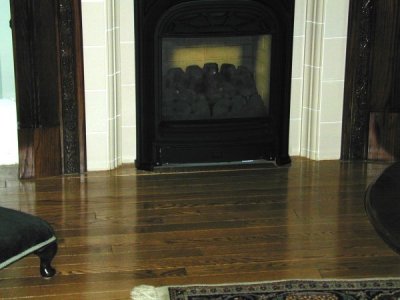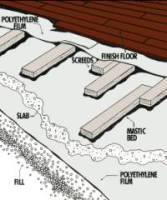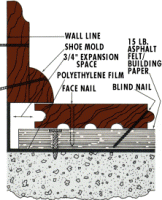
Figure 1 - Hardwood flooring
Hardwood is generally installed by driving a nail or staple at a 45-degree angle through the exposed tongue of each individual hardwood board. By doing so, you not only nail the board to the sub-floor, but you force the board you are nailing hard up against the previous board, removing any gaps that may appear between the boards.
If you have a concrete sub-floor, this method of installation cannot be used. It should be noted that hardwood should not be installed below grade or on any concrete slab that is in direct contact with the ground. Moisture transmitted from the ground, through the slab will permeate the hardwood and cause it to buckle, warp, and possibly rot. The only hardwood that should be installed on a below or on-grade concrete slab is engineered hardwood.
If you have an above grade concrete slab and wish to install a hardwood floor it must be glued to the concrete floor. Only certain hardwood boards can be glued and the manufacturers will specify which ones within their product lines are designed for glue down
installation.
Almost all hardwood flooring is manufactured with a tongue and groove. The tongue and grove provide a method whereby the boards are held level when placed side by side. However, tongue and groove is not necessarily a locking system and unlike engineered hardwood, where the tongue and groove actually interlock to each other (in most cases) so that the boards cannot be separated, a regular hardwood board or plank does not interlock together. This creates a challenge when using the glue down installation method as it makes it difficult to squeeze boards or planks together. Any boards that have a slight warp or curve are difficult to use.
Whereas it is relatively easy for a home handyman to install a hardwood floor over a wood sub-floor, it takes some additional expertise to successfully install the same floor on a concrete slab.

Figure 2 - Hardwood flooring on concrete using screeds

Figure 3 - Hardwood flooring on concrete using plywood
Note: You can install a wood sub-floor over the concrete floor. In that case you would be installing the hardwood flooring on a wood floor. Moisture control is critical if you use a sub-floor method. There are two basic methods to create a sub-floor as shown in Figures 2 and 3 above:
Many high-rise condominiums have very specific flooring rules. In most cases, these rules are designed to lessen the sound transmission from the apartment or unit floor above to the apartment or unit directly below.
Hardwood transmits sound extremely well and if sound transmission is a concern or it is regulated, it is usually necessary to install, using glue, rolled cork over the concrete before installing the hardwood. The cork acts as a buffer to the transmission of sound. In some cases, the installation cost of the cork, per square foot, can be equal to the installation of the hardwood floor itself.
Additional information on hardwood flooring.
